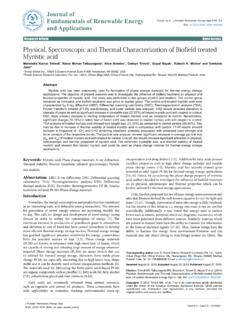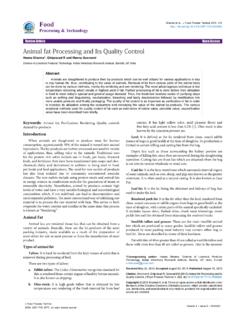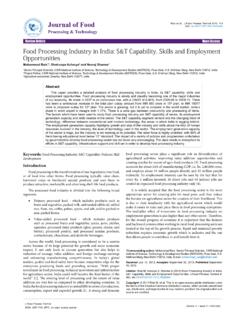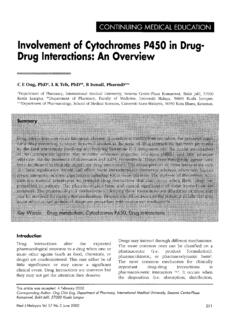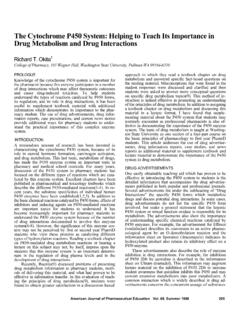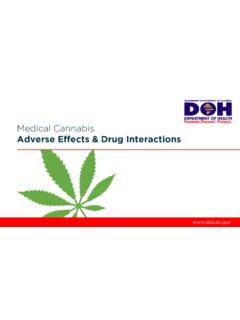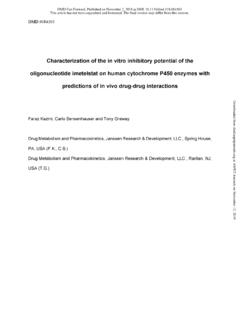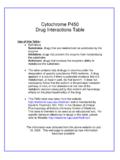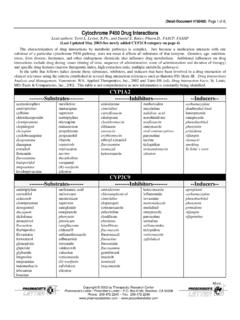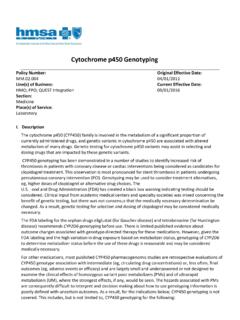Transcription of P Journal of Mora, et al, Clin Ep Pharmacol 215, 5:3 ...
1 Mora, et al., Clin Exp Pharmacol 2015, 5:3 DOI: AccessResearch Article Volume 5 Issue 3 1000176 Clin Exp PharmacolISSN: 2161-1459 CPECR, an open access journalCYP450 and Its Implications in the Clinical Use of Antipsychotic DrugsFernando Mora1, Juan D Molina2*, Elena Zubillaga3, Francisco L pez-Mu oz4,5,6 and Cecilio lamo71 Psychiatry Service Infanta Leonor University Hospital, Madrid, Spain2 Short term Hospitalization Unit, Dr. Rodr guez Lafora Hospital, Madrid, Spain3 Medical Department, Janssen, Spain4 Chair of Genomic Medicine and Faculty of Health Sciences, Camilo Jos Cela University, Madrid, Spain5 Department of Pharmacology, Faculty of Medicine, University of Alcal , Madrid, Spain6 Neuropsychopharmacology Unit, Hospital 12 de Octubre Research Institute, Madrid, Spain7 Department of Pharmacology Faculty of Medicine, University of Alcal , Madrid, SpainAbstractPolypharmacy implies a high potential for drug - drug interactions .
2 The capacity of the cytochrome p450 enzyme system involved in the metabolism of psychoactive drugs differs greatly, which leads to variable drug elimination rates and inter-subject differences in serum drug concentrations. Polymorphisms in genes coding for CYP450 enzymes contribute to this inter-subject variability. Therapeutic response and adverse effects vary among patients treated with the same dose of a certain drug . Polypharmacy, comorbidity and the use of certain substances (grapefruit juice, caffeine and tobacco) increase the chances of clinically relevant interactions in a psychotic patient.
3 Choosing drugs with low interaction potential seems to be the best strategy to prevent clinically relevant interactions particularly in elderly, polymedicated, oncologic and HIV patients.*Corresponding author: Juan de Dios Molina, Short term Hospitalization Unit,Dr. Rodr guez Lafora Hospital, Ctra de Colmenar Viejo, Madrid-28049, Spain, Tel:+34 915 86 75 00; E-mail: April 15, 2015; Accepted: May 12, 2015; Published: May 25, 2015 Citation: Mora F, Molina JD, Zubillaga E, L pez-Mu oz F, lamo C (2015) CYP450 and Its Implications in the Clinical Use of Antipsychotic Drugs.
4 Clin Exp Pharmacol 5: 176. : 2015 Mora F et al. This is an open-access article distributed under the terms of the Creative Commons Attribution License, which permits unrestricted use, distribution, and reproduction in any medium, provided the original author and source are : CYP450; drug interactions ; Antipsychotic;Pharmacokinetic; PolypharmacyIntroductionDrug- drug interactions (DDIs) are very common in clinical practice and are responsible for substantial increase in patient s morbidity and mortality.
5 Globally drug - drug interactions are responsible for approximately 20% to 30% of notified adverse reactions [1,2]. It has been estimated that the risk for drug - drug interactions increases substantially to about 84% when the number of concomitants drugs rise from 2 to 6 agents [1]. In addition, it is known that there is a great variability between individuals, and therefore, drug - drug interactions are not always easy to recognize [3,4]. drug concentration at the site of action is regulated by absorption, distribution, metabolism, and excretion.
6 Therefore, all these processes are keys to the pharmacologic action as well as the therapeutic efficacy and safety. A drug with unfavorable pharmacokinetic properties may result in an inadequate or inconsistent response, which may put the therapeutic use at risk. In addition, pharmacokinetics of a drug is usually a key factor for the appearance or absence of toxic effects, and as a result, it has a direct impact on the safety of treatment [5]. drug - drug interactions resulting from absorption, distribution, metabolism, or elimination, as well as pharmacodynamic factors, are present for many common psychoactive medications.
7 DDIs can negatively impact patient outcomes and can also have serious implications on the cost and quality of treatment. DDIs may be the cause of adverse drug reactions (ADRs) that put at risk the outcomes of therapy and the adherence to treatment [6,7].The potential for DDIs is particularly increased in the elderly due to polytherapy. In fact, polypharmacy increases the complexity of therapeutic management, and therefore, the risk of clinically relevant DDIs, which can both induce the development of ADRs or reduce the clinical efficacy.
8 The challenge presented by adverse DDIs in clinical psychiatry will continue to expand as the complexity of medication regimens increase in a population that receive more sophisticated and diverse psychotropic agents [8,9]. Most individuals with schizophrenia take medications indefinitely and at some point take additional medications. Therefore, the risk of polypharmacy-related complications is real in this population as well as the risk of reduced adherence to treatment [6,7].
9 The aim of the present article is to review and update common drug - drug interactions and its implications in the clinical use of antipsychotic drugs with a special focus on interactions associated to CYP450 enzymes (CYP s) interactionsThe two main types of DDIs are pharmacodynamic and pharmacokinetic interactions : In a pharmacodynamics interaction, two drugs have synergistic or antagonistic effects, without changes in their pharmacokinetic profile. There are many examples of pharmacodynamic interactions with , some antipsychotics with anticholinergic properties, as clozapine, chlorpromazine and trifluoperazine, can cause constipation.
10 The association of these agents with opioids, for example codeine, increased the constipation. Furthermore, the synergistic anticholinergic effect of drugs, such as antiparkinsonian agents, can increase the anticholinergic effects of these antipsychotics, leading to dry mouth, blurred vision, and possibly delirium [10].Potential pharmacodynamic interactions can be present with addition of many other drugs to antipsychotics. This includes all sedative drugs, as benzodiazepines, antihistaminics, some antidepressants, increasing the risk of sedation.

